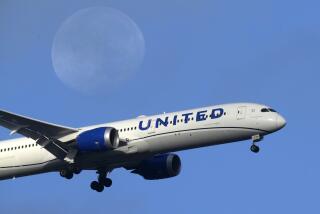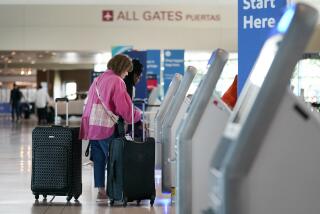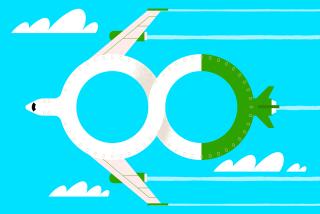Frequent fliers may find ‘tis better to redeem than receive
Hi, my name is Jim, and I am a frequent-flier junkie. Even though I have 300,000 miles in my frequent-flier account, I have taken unnecessary trips to far-off locations to earn miles. I have flown my preferred airline even when it is not the most convenient or the least costly. I have charged purchases that I might not otherwise have made on a credit card that gives miles. I have paid for flights when I might have used an award ticket.
As a premium flier, I get perks such as upgrade coupons and double miles, so that’s an incentive for some of my behavior. But part of it, I confess, is just driven by the urge for more miles.
An economist would likely tell you that my behavior is questionable -- and that I have plenty of company. Eighty-three million of us are members of at least one frequent-flier program.
At current rates of redemption, it would take nearly 23 years to redeem the 9.1 trillion miles in frequent-flier accounts at the end of 2002. In 10 years, the number of unused miles has sextupled, but our redemption of miles has only slightly more than doubled. We are earning far more miles than it will ever be possible to redeem.
“If people have more miles than they can use, [trying to earn more] is not rational,” says Steven Morrison, a professor of economics at Northeastern University in Boston.
Morrison did a study that showed that consumers would be willing to pay up to 8 cents for a frequent-flier mile. Unfortunately, that mile is worth only about 2 cents. “It looked like a paradox to us,” says Morrison. “But it was not ... to the marketing profession.”
Indeed, marketers are smiling. The airlines earn about $2 billion annually on these programs by selling miles to third parties. Between actual miles flown, credit cards and opportunities to earn miles on transactions as diverse as buying flowers and financing mortgages, we earned a record 1.65 trillion miles in 2002 but redeemed only a quarter of them.
“They have gone from frequent-flier programs to frequent buyer programs,” says Randy Petersen, editor and publisher of Inside Flyer magazine and a frequent-flier program guru.
With more miles chasing about the same number of awards, it becomes more difficult to redeem them.
“What I hear anecdotally is people with more complaints” about not being able to redeem miles, says Tim Winship, editor and publisher of Frequent Flier.com. “Unfortunately there are no reliable statistics. The Department of Transportation should be tracking complaints very specifically about frequent-flier programs, but they don’t.”
The airlines have created, in many ways, the perfect customer loyalty program. The costs of the awards are marginal. There cannot be a “run on the bank” because the airlines control the number of seats, and the airlines can change the rules at will. But there are potential problems.
“There is a fear of consumer backlash,” says Jared Blank, an airline industry analyst with Jupiter Research, a market research firm. “If airlines don’t have enough seats available, consumers will give up on the program.”
Here’s what experts suggest for getting the most benefit from our hard-earned frequent-flier miles:
* Start redeeming. “The value of frequent-flier miles is in decline,” Winship says. This year he has gone from being a mileage hoarder to a spender. “Redeem sooner rather than later,” he says. “You’re going to have more trouble getting an award if you wait.”
* Pay attention to costs. Use the 2-cent-per-mile figure as a baseline. If you are paying more for your ticket than you would on another airline, figure out what earning those miles is actually costing you. If it is more than 2 cents, take the cheaper flight and forget about those miles.
* To get increased availability, use more miles. “Every seat every day is available,” Petersen says -- if you’re willing to spend 40,000 miles or more for a domestic coach ticket, about 15,000 more miles than a saver-award coach ticket.
* Switch loyalty credit cards. Try a hotel credit card or a card that gives 2% cash back and buy your ticket with your savings. In April, with one day’s notice, I got a room at the Park Lane Sheraton Hotel in London using Starwood points, the value of which is about equivalent to an airline mile. With no blackout dates, they’re easier to use than my airline miles.
* Book further out or closer to your dates. The airlines release their primary allotment of frequent-flier seats 330 days ahead. They release more award seats as the date of the flight approaches. It may be easier to make a reservation 20 days in advance rather than 45 days, Petersen says.
* Use your miles for upgrades. Upgrades have become more costly and difficult to come by in the last year, but they are still one of the best values per mile in terms of relative cost to reward.
* Complain if it’s warranted. It is important for the health of the airlines, and consequently for the health of your cache of miles, that the airlines know whether they are doing a good job. If you can’t book a flight when you want to and you think it is a reasonable request, send a letter. Many airlines’ Web sites have forms you can fill out, or e-mail the U.S. Department of Transportation at airconsumer @ost.dot.gov.
Taking all this to heart, I decided to use miles for a flight from Los Angeles to London in September, but I couldn’t book an award seat. So I paid for a ticket. At least I’ll be earning miles on my flight.
James Gilden can be reached through his Web site, www.theinternettraveler.com. Travel Insider welcomes comments and suggestions but cannot respond individually to letters and calls. Write Travel Insider, Los Angeles Times, 202 W. 1st St., Los Angeles, CA 90012, or e-mail travel@latimes.com.
More to Read
Inside the business of entertainment
The Wide Shot brings you news, analysis and insights on everything from streaming wars to production — and what it all means for the future.
You may occasionally receive promotional content from the Los Angeles Times.










